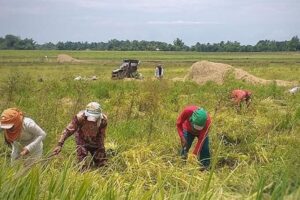
After enacting a harebrained law known as Rice Tariffication Law (RTL), or Republic Act No. 11203, ostensibly to “reduce” or “rationalize” rice prices by tossing to the unrestrained private sector the task of controlling the rice industry and thus “guarantee” food security, the gallant members of Congress now, not wanting to be blamed for the neoliberal tragedy, seek to put lipstick on the pig, as if using cosmetics would rid the law of its evil substance.
Those who championed the RTL, like Sen. Cynthia Villar, posed as bleeding hearts out to “modernize” the rice industry and “rationalize” prices by hitting hoarders through massive importations, to the extent that the statistical portal Statista reported that between 2023 and 2024, the Philippines imported 3.8 million metric tons (MMT) of rice, making our agricultural country the biggest importer of the staple. To ensure that the National Food Authority (NFA) would have no hand in disciplining the market, the agency was relegated to maintaining a buffer stock. Previously, NFA was buying up to 10% of palay output as the rice deficit never exceeded 7.5% of the total yield. When prices rise, the NFA could not release more rice stocks to the market to temper price increases.
Enacted nearly five years ago under the guidance of neoliberal economists long guilty of killing the agricultural sector, RTL deified the free market and maintained that the unseen hand would make the market most efficient. The market would correct itself to ensure that there is rice in every pantry, palay in every warehouse and sacks of rice in every nook and cranny. The government, from the unlamented Gloria Macaraeg Macapagal Arroyo regime to the current administration of Ferdinand Marcos Jr., only succeeded in worsening the situation as uncontrolled rice imports have forced farmers to shift to other crops. Domestic output cannot increase as Vietnamese and Thai farmers are subsidized by their governments.
In spite of the huge importations, rice prices that were supposed to go south have gone north, and the Kilusang Magbubukid ng Pilipinas (KMP) grieves as the entire industry has suffered P344-billion in losses. “Congress created the problem that is the rice tariffication. Lawmakers cannot simply undo the problem by tweaking parts and provisions of the abominable law. Rice tariffication should be scrapped altogether and replaced with a measure that will genuinely uplift the status of rice farmers and the rice industry,” KMP chairperson Danilo Ramos argued
By worshiping market forces, RTL delivered to the private sector the production, supply, and distribution of rice, resulting in the highest price inflation in the country at 22.6%. “To address the Marcos Jr government’s epic failure in lowering rice prices, Congress is now turning to RA 11203 amendments, even if they knew that it would do nothing in changing the rice crisis,” KMP explained. “Allowing the NFA to sell rice again and a well-targeted Rice Competitiveness Enhancement Fund (RCEF) won’t cut it. Government should rehabilitate the production side and implement core programs such as production support, farm inputs support as well as a rice lands and rice industry protection program to repair the damages of the RTL,” Ramos said.
The RTL is a strange piece of legislation. It allows the private sector to control rice trade, and thus necessarily meddles with palay output since it is allowed to determine when to import rice and when it imports more rice than needed, it prevents farmers from cultivating palay. Moreover, RLL talks of the RCEF and the revenue collected from importers (smugglers necessarily maintain tax-free operations) will be large when they exceed the demand. Villar and company talk as if the RCEF will be the salvation for millions of rice farmers, but the RCEF will only be huge with uncontrolled importations. In short, this fund is the product of a wrong policy. Villar and her cohorts argue that Filipino rice farmers will become competitive with RLL because of RCEF, which is exactly what is meant by thinking from the rear. Farmers will not be competitive as RLL will kill them for the benefit of property developers who argue that “maraming lupa sa Pilipinas” and who also control water districts and have coveted land in Luzon, Visayas and Mindanao for their residential, commercial and industrial projects as well as their memorial parks.
Calculating the demand using the daily per capita consumption (PCC), importers can purchase the volume to satisfy the PCC for 9 months, providing the market with supply for 6 months and keeping the rest to push prices up. With their large warehouses, importers can let the supply drip, drip and drip into the market to influence prices. Importers are guided by the profit motive, not by any patriotic slogan or altruism. They know that the beyond 6 months, the eating quality of rice deteriorates, especially the low-quality rice from drought-stricken Mekong Delta, where 90% of Vietnam’s exports comes.
Tweaking RTL to make it palatable insults the intelligence of farmers and consumers since it is like polishing turd. Treat that wrong piece of law for what is, as a compendium to the Charter change misadventure of the Marcos administration. It didn’t make sense nearly 5 years ago and it doesn’t make sense now. Just cremate that law and bury it in one of Villar’s overvalued memorial parks. (DEO MAGNO)